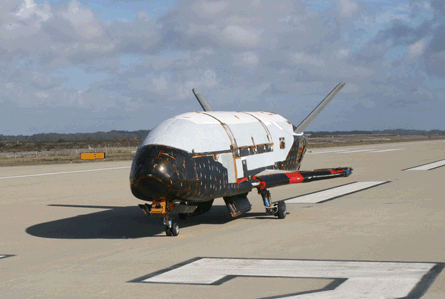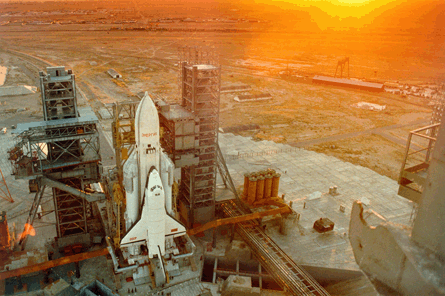By Alexander Zudin
Russian Space Forces researchers are working on an unmanned reusable spacecraft similar to the US Air Force's Boeing X-37 orbital test vehicle, the head of the armed forces unit dedicated to military space operations has revealed.
Oleg Ostapenko, speaking just weeks after the end of the X-37B's maiden, 220-day mission, said: "Something has been done along these lines, but as to whether we will use it, only time will tell."
A move by Russia to develop a reusable spaceplane harks back to the Soviet Union's Buran space shuttle project. Buran was similar in concept and size to NASA's Space Shuttle, though the orbiter was designed to carry a much larger payload to orbit - 30,000kg compared with 17,000kg for the Shuttle.
According to NASA, Buran was launched once, in November 1988, orbiting twice before returning to the ground. The programme, however, was cancelled in 1993.
 |
|---|
© USAFRussian Space Forces researchers are working on an unmanned reusable spacecraft similar to the US Air Force's Boeing X-37 (above) |
Now that the Space Shuttle is preparing for its final two flights before the fleet is retired, both US and Russian programmes to develop reusable spaceplanes are in their infancy and, perhaps, embarking on a new space race. But neither country is developing anything resembling a replacement for Space Shuttle's capabilities. At 8.9m (29.25ft) long and with a 4.5m wingspan, the Boeing-built X-37B is much smaller than the 37m (122ft)-long Shuttle. The USAF has not revealed the 4,990kg (11,000lb) vehicle's orbit parameters or payload but, being unmanned, it is clearly not a direct replacement for the Shuttle, and Ostapenko's brief remarks about a Russian programme suggest a craft with similar limitations.
So far, all indications are that the X-37B programme is a success. The craft, launched on 22 April 2010 from Cape Canaveral, made an autonomous re-entry and returned safely to land at Vandenberg AFB on 3 December, after 224 days in orbit. The USAF has not disclosed details of the mission, but programme manager Lt Col Troy Giese, of the Air Force Rapid Capabilities Office, says X-37B conducted on-orbit experiments for more than 220 days during its maiden flight and completed all on-orbit objectives. He says: "The vehicle performed everything it was asked to do this particular flight, so now we need to see how the materials operated in this long duration and examine the vehicle, since it was designed to operate for long periods of time."
Gliese says the programme is intended to perform risk reduction, experimentation and concept of operations development for reusable space vehicle technologies, adding that the first flight "culminates a successful mission based on close teamwork between the 30th Space Wing, Boeing and the Air Force Rapid Capabilities Office".
Following what Gliese calls a "refurbishment phase", a second launch, again via a Lockheed Martin Atlas V booster, is being readied for this spring.
While the Shuttle always had a military aspect to its operations, its inherent flexibility and manned configuration made it the standard-bearer for US civil and scientific space flight for 30 years. X-37B, or whatever operational vehicle may follow it, is clearly being developed for military use. As Richard McKinney, deputy under-secretary of the Air Force for space programmes, puts it: "We're in a very serious and important business of providing national security space capabilities for our nation. Some of those capabilities are state-of-the-art, highly complex and very technical."
 |
|---|
Russia has already developed a reuseable space vehicle, the Buran space shuttle (above) which was launched once, in 1988. The programme, however, was cancelled in 1993 |
He adds that the ability to examine such technologies as space situational awareness, intelligence, surveillance and reconnaissance, and satellite development before they are made operational "is a long-sought-after capability that the X-37B provides. Now we can test those capabilities long in advance of putting them in operational space."
The Air Force describes X-37B technologies as being one generation beyond the Space Shuttle's, though the design, which dates to the late 1990s, has a Shuttle-like outer mould line. The programme's objectives are as much about developing fast, low-cost turnaround between flights as about on-orbit performance, though the facility to inspect it after lengthy periods in space is deemed critical.
While the X-37B may look like a small, unmanned version of the Space Shuttle, it is better thought of as a satellite capable of, on command from the ground, folding up its solar array and safely re-entering the atmosphere. Ground controllers cannot take over the re-entry flight, but can destroy the craft should it stray from pre-determined safety boundaries.
Gary Payton, US Air Force under-secretary for space programmes, has told Flight International that the goal of the X-37B programme is to be able to land the craft and fly it again less than 10-15 days later: "If we were in a surge environment, where we were putting up a whole bunch of satellites over a month or two, I would like to see the X-37B handle much more like a [Lockheed] SR-71."
The USAF has contracted Boeing to build a second X-37B for delivery this year, but has not yet manifested the vehicle on an Atlas V, and intends to learn what it can from the first craft before pressing the second into service.
- Additional reporting by John Croft in Washington DC and Dan Thisdell in London
Source: Flight International


























